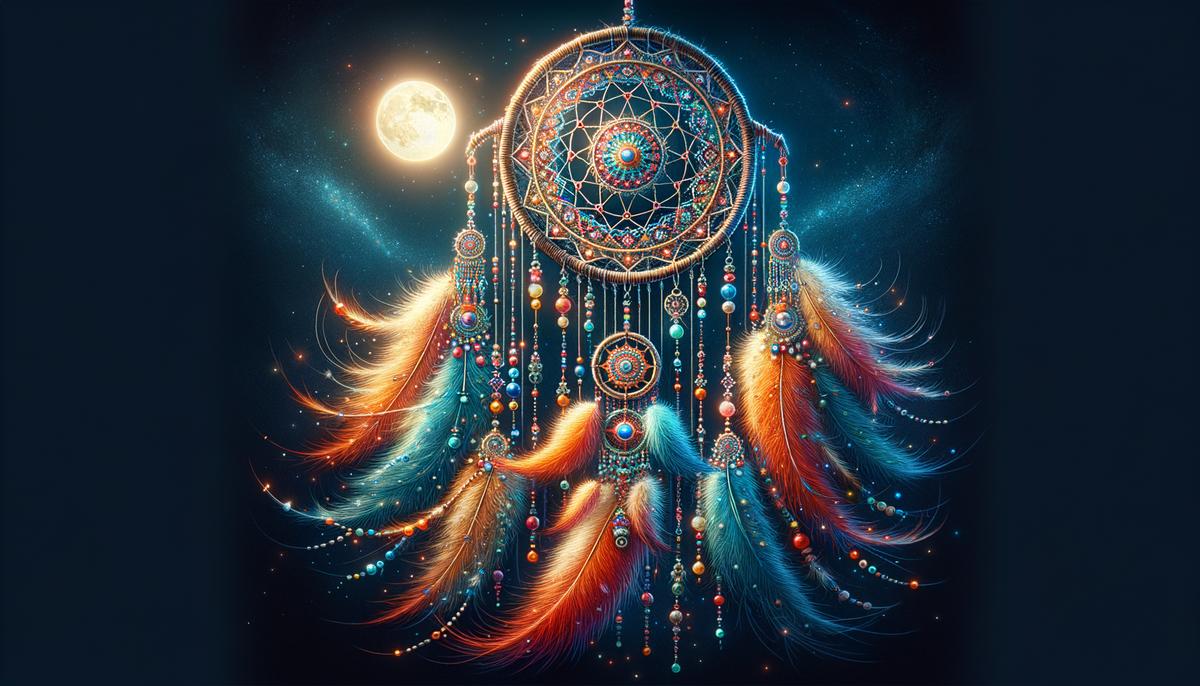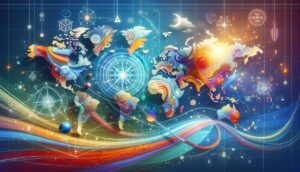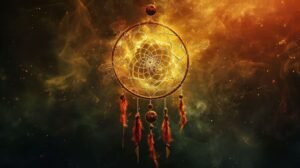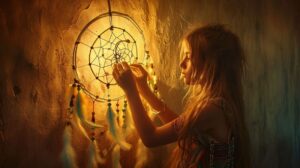Dreamcatchers conjure images of intricate webs and feathers fluttering gently in the night air. Often found hanging by a window or above a bed, these beautiful artifacts hold much more than aesthetic appeal—they carry deep spiritual significance, rooting back to ancient Native American traditions. Let’s unwrap the layers of mystery and explore the rich history and modern relevance of dreamcatchers.
The Traditional Dreamcatcher Explained
Dreamcatchers may appear simple, but their design and function weave a complex tale. Let’s decode their structure and understand their protective charms:
-
What is a Dreamcatcher?
Traditionally, a dreamcatcher consists of a round frame made from willow, adorned with a net-like web, beads, and feathers hanging below. Each component is not just decorative but symbolically significant. -
Protection from Bad Dreams:
According to tradition, the web catches the bad dreams, trapping them until daylight dissolves them. Good dreams, knowing their way through the web, slide down the feathers to the sleeping person below. -
Symbolic Elements:
-
The Web: Represents the spider's web which ensnares all harm.
-
The Hoop: Symbolizes the circle of life and the continuous flow of energy.
-
Beads and Feathers: Beads can symbolize trapped dreams; feathers act as a soft ladder for good dreams to descend.
Native American Roots of the Dreamcatcher
The roots of the dreamcatcher are deeply embedded in Native American cultures, primarily the Ojibwa (Chippewa) Nation. Let’s delve into its historical context and journey:
-
Origin with the Ojibwa:
Dreamcatchers originated with the Ojibwa people as a protective talisman. It was used to safeguard infants and sleeping individuals from negative dreams. -
Adoption and Adaptation:
The use of dreamcatchers spread from the Ojibwa to neighboring tribes through intermarriage and trade. Each tribe infused it with their unique symbolism and stories. -
Folklore and Legends:
A prominent legend speaks of a mystical spider woman who would weave magical webs to protect the sleeping children. The dreamcatcher is a symbolic representation of her protection.
The Spiritual Significance in Indigenous Cultures
Dreamcatchers hold profound spiritual significance beyond their role as protectors in the night. Explore how they embody the sacred connections to nature and the spirit world:
-
A Spiritual Guardian:
For many indigenous peoples, dreamcatchers serve as a connection to the spiritual world, guarding against not just bad dreams but also negative spirits. -
Connection to Nature:
Materials used in making a traditional dreamcatcher are natural, emphasizing the deep bond and respect for nature prevalent in Native American cultures. -
Dream Symbolism:
Dreams are not just nighttime meanderings of the mind; they are messages from the spirit world or deep reflections of inner desires and fears.
Crafting a Dreamcatcher: Materials and Methods
Interested in the traditional art of crafting a dreamcatcher? Here’s a simplified guide that outlines the methods and meanings of the materials used:
-
Choosing the Hoop:
Traditionally, the hoop is made from a bent Red Willow branch, cleansed and blessed in a particular manner. Willow is chosen for its flexibility and sacred significance. -
Weaving the Web:
- Start at the hoop's top and weave sinew or thread in a web-like pattern.
- Symbolism: The pattern represents the web of life and how lives are interconnected.
-
Decorating with Feathers and Beads:
- Feathers: Typically hung from the hoop using sinew or thread. They symbolize breath or air, essential for life.
- Beads: Represent the spider—the weaver of the web. Sometimes, a single bead is placed in the web’s center to signify the spider's heart.
This cultural artifact, steeped in history and spiritual importance, offers not just a protective aura but also a beautiful reminder of the interconnectedness of life and the gentle protection afforded by the universe. Whether you're a spiritual seeker or simply fascinated by indigenous arts, understanding and respecting the heritage of the dreamcatcher opens up a serene, protective space in modern homes and hearts.
Dreamcatcher Variations Across Cultures
As we continue to explore the captivating world of dreamcatchers, it's evident that their intrigue isn't confined to one culture. While rooted in Native American traditions, the dreamcatcher has evolved, embracing numerous forms and meanings across different cultures. Let's delve into these global adaptations and the unique interpretations they bring to the traditional dreamcatcher design.
Cultural Adaptations and Their Meanings
From North to South America and beyond, indigenous cultures have embraced the dreamcatcher, each adding a personal touch:
- South American Tribes: Similar to their North American counterparts, some South American tribes use elements like feathers and beads, but often incorporate vibrant colors and unique patterns that reflect their tropical environment.
- Canadian First Nations: Here, you'll find dreamcatchers that often include materials like caribou sinew, integrating local wildlife elements into their design.
Modern Artistic Interpretations
Artists worldwide have reimagined dreamcatchers, transforming them from a cultural artifact to a piece of global art:
- Urban Art Installations: Large-scale dreamcatchers as a form of street art, symbolizing urban unity and protection.
- Fashion and Jewelry: Adaptations in accessories that preserve the aesthetic while being wearable art.
Intentions and Resonance in Different Cultures
Each cultural touch adds layers of meaning, showing that the fundamental human desire to seek protection and connection through objects of power is universal:
- Protective Charms: In many cultures, regardless of the form it takes, the dreamcatcher serves as a protective talisman against evil spirits or misfortune.
- Symbols of Unity: Often symbolizing unity and the interconnectedness of life, emphasizing harmony within communities.
Dreamcatchers in Modern Day Life
In modern times, the dreamcatcher has transcended its original spiritual purposes, becoming a popular item in home decor and a symbol frequently seen in media. However, this surge in popularity brings with it debates over cultural integrity and commercialization.
Commercialization and Popularity
Dreamcatchers have found a place in almost every corner shop and home decor store, but at what cost?
- Home Decor: Often marketed as exotic and trendy additions to modern homes, available in a range of sizes and styles.
- Media Representation: Featured in movies, TV shows, and books, sometimes stripped of their traditional context and portrayed simply as decorative items.
Misconceptions and Exploitation
With popularity comes a responsibility to maintain the object's cultural integrity:
- Cultural Misunderstandings: The commodification can lead to widespread misconceptions about the dreamcatcher's origins and meanings.
- Commercial Exploitation: Mass production, often by non-indigenous businesses, raises concerns about cultural theft and the dilution of a sacred tradition.
Dreamcatchers and Cultural Respect
As dreamcatchers continue to weave their way into the tapestry of global culture, the conversation around cultural respect becomes more crucial. Understanding the line between appreciation and appropriation is key to honoring the dreamcatcher's origins and significance.
Navigating Appreciation vs. Appropriation
A sensitive approach can make all the difference:
- Education and Awareness: Learning about the dreamcatcher’s roots and the significance it holds in Native American cultures encourages respectful engagement.
- Supporting Indigenous Artisans: Purchasing authentic dreamcatchers made by indigenous people supports cultural preservation and provides economic benefits to the rightful communities.
Ethical Considerations in Modern Day Use
Here's how you can honor the dreamcatcher's heritage while enjoying its beauty:
- Seek Authentic Sources: Choose dreamcatchers crafted by Native artisans. This not only lends authenticity but also ensures cultural practices are respected.
- Cultural Sensitivity: Be mindful of how and where you display dreamcatchers, understanding their intended use and spiritual significance.
Conclusion
From its roots in Native American heritage to its place in homes around the world, the dreamcatcher’s journey is a testament to the power of cultural symbols. As we hang these intricate creations in our homes or gift them to loved ones, let’s remember to honor the rich cultural history they carry. Respecting and preserving the traditional values and practices associated with dreamcatchers allows us to appreciate not just their beauty, but their profound spiritual significance as well.
Reflect and engage: Have you ever experienced the protective charm of a dreamcatcher? How do you ensure cultural respect in your choice of decor? Share your thoughts and experiences to enhance our collective understanding and appreciation.





0 Comments